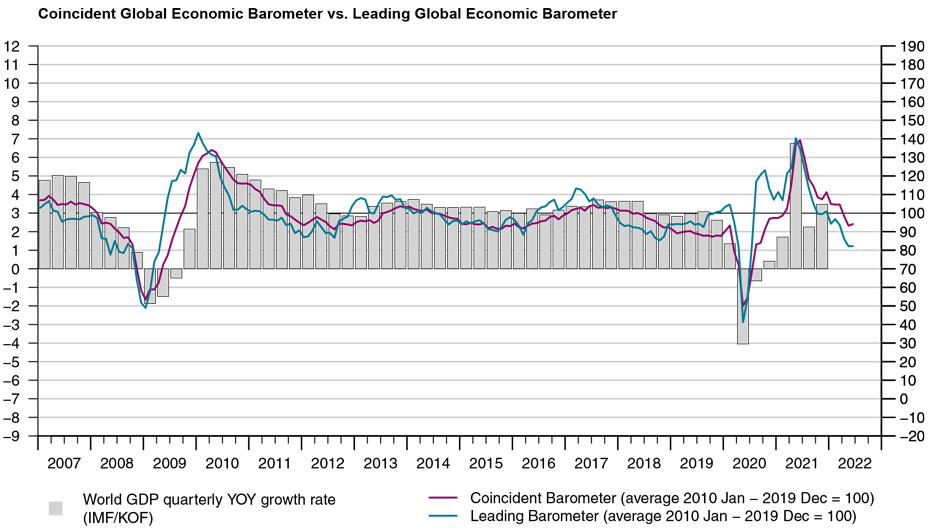Global Barometers stabilize at a low level
In June, the Global Barometers are quite stable, following noticeable falls in the two previous months. The Coincident Barometer rises a little and sustains a level compatible with moderate growth of the world economy in the second quarter. However, the current stability of the Leading Barometer continues to reflect a skeptical outlook for global economic growth in the months ahead.
The Coincident Global Economic Barometer climbs 0.9 points in June to 94.1 points, after losing 11.4 points during April and May. The Leading Global Economic Barometer remains stable this month at 82.2 points. The results of the indicators are influenced by the improvement in current assessments and the outlook for the coming months in the Asia, Pacific, and Africa region alongside a worsening of perceptions in the other regions.
"In the past month, the situation assessments and future prospects of survey participants from all over the world have at least not deteriorated further. However, supply shortages have not disappeared and central banks are increasingly challenged to clearly respond to ongoing high inflation. Together with the war in Ukraine, the accompanying concerns about energy shortages in Europe, and the uncertainties surrounding the COVID-19 policy in China, the outlook for the coming months remains rather gloomy”, evaluates Jan-Egbert Sturm, director of KOF Swiss Economic Institute.
Supply shortages, inflation, the war in Ukraine, concerns about energy shortages in Europe, and the uncertainties surrounding the COVID-19 policy in China - however, the outlook for the coming months remains rather gloomy.Jan-Egbert Sturm

Coincident Barometer – regions and sectors
In June, the Asia, Pacific, and Africa region was with 2.3 points the only region to contribute positively to the increase in the Coincident Global Barometer. The indicator for Europe contributes -0.9 points and the Western Hemisphere contributes -0.5 points. The gradual rise in the global indicator appears to be mainly related to the gradual recovery of the Chinese economy after the easing of mobility restrictions adopted to combat the COVID-19 outbreak. The graph below illustrates the contribution of each region to the deviation of the Coincident Barometer from the historical mean of 100 points.
Among the coincident sector indicators, only Industry and the general state of the Economy (aggregated business and consumer evaluations) increase slightly this month. The other sectors all decrease. All five sector indicators remain below the historical mean of 100 points and Construction continues to be the sector with the lowest level.
Leading Barometer – regions and sectors
The Leading Global Barometer leads the world economic growth rate cycle by three to six months on average. In June, the global indicator remains at 82.2 points, the lowest level since April 2009, except for four observations in 2020. The Asia, Pacific, and Africa region contributes positively this month with 1.6 points, while Europe and the Western Hemisphere contribute in the opposite direction with -1.1 and -0.5 points, respectively. The economic slowdown to control the pandemic in China, alongside the war in Ukraine, the high inflation rates and the adoption of more restrictive monetary policies in various countries has led to a worsening of expectations for global growth in 2022. The latter factors also contribute to maintaining the low level of the global leading indicator.
In June 2022, there is a fall in four of the five leading indicator sectors. Only the indicator for the general state of the Economy (aggregated business and consumer evaluations) increases this month. Despite the rise, it is the only indicator oscillating in the band of 70 points. All the other sector indicators are in the band of 80 points.

The Global Economic Barometers
The Global Economic Barometers are a system of indicators enabling timely analysis of global economic development. They represent a collaboration between the KOF Swiss Economic Institute of the ETH Zurich in Switzerland and Fundação Getulio Vargas (FGV), based in Rio de Janeiro, Brazil. The system consists of two composite indicators, the Coincident Barometer and the Leading Barometer. The Coincident Barometer reflects the current state of economic activity, while the Leading Barometer provides a cyclical signal roughly six months ahead of current economic developments.
The two Barometers comprise the results of economic tendency surveys conducted in more than 50 countries with the aim of achieving the broadest possible global coverage. The advantages of economic tendency surveys are that their results are usually readily available and are not substantially revised after first publication.
The Coincident Barometer includes more than 1,000 different time series, while the Leading Barometer consists of over 600 time series. Cross-correlation analysis is used to decide which individual time series are included in the barometers. This involves correlating the individual time series with a reference series. The reference series used is the year-on-year growth rate of global gross domestic product (GDP), where the individual national GDPs are aggregated at purchasing power parity to form global GDP. A time series is only included in a Barometer if it shows a sufficiently high correlation and a suitable synchronization or lead with the reference series. The time period used for this correlation analysis currently runs from January 2010 to December 2019.
The series of the two Barometers are revised each month at publication and are standardized to have a mean of 100 and a standard deviation of 10 for the 10-year period previous to the most recent observations.
The methodology is described in:
Klaus Abberger, Michael Graff, Aloisio Jr. Campelo, Anna Carolina Lemos Gouveia, Oliver Müller and Jan-Egbert Sturm (2020), The Global Economic Barometers: Composite indicators for the world economy. KOF Working Papers, vol. 471, Zurich: KOF Swiss Economic Institute, ETH Zurich, 2020.
Contact
KOF Konjunkturforschungsstelle
Leonhardstrasse 21
8092
Zürich
Switzerland